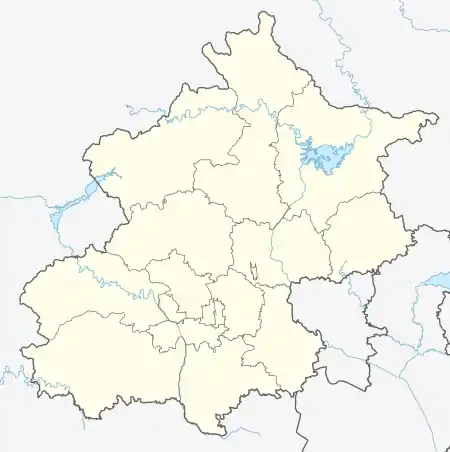Baizhifang Subdistrict
白纸坊街道 | |
|---|---|
.jpg.webp) Wanboyuan Community, Baizhifang Subdistrict, 2020 | |
 Baizhifang Subdistrict  Baizhifang Subdistrict | |
| Coordinates: 39°52′52″N 116°21′40″E / 39.88111°N 116.36111°E | |
| Country | China |
| Municipality | Beijing |
| District | Xicheng |
| Area | |
| • Total | 3.11 km2 (1.20 sq mi) |
| Population (2020) | |
| • Total | 82,022 |
| • Density | 26,000/km2 (68,000/sq mi) |
| Time zone | UTC+8 (China Standard) |
| Postal code | 100054 |
| Area code | 010 |
Baizhifang Subdistrict (Chinese: 白纸坊街道; pinyin: Báizhǐfāng Jiēdào) is a subdistrict on the southwest part of Xicheng District, Beijing, China. As of 2020, it has a total population of 82,022.[1]
This subdistrict got its name due to its historical status as a paper manufacturing hub. In 1272, the Ministry of Rites set up Baizhifang (Chinese: 白纸坊; lit. 'White Paper Workshop') as a producer of paper for government usage, and the surrounding area got the same name as the institution.[2]
History
| Time | Status |
|---|---|
| Liao dynasty | Part of Southwest District of Southern Capital |
| Jin dynasty | Within the city of Zhongdu |
| Yuan dynasty | Part of Baizhifang |
| Ming dynasty | Surrounding areas were incorporated into Baizhifang |
| Qing dynasty, Reign of Qianlong Emperor | Part of Western City |
| Qing dynasty, Reign of Guangxu Emperor | Part of Right 4th Outer District |
| 1912 | Part of 4th Outer District |
| 1949 | Part of 11th District |
| 1950 | Part of 8th District |
| 1952 | Part of Xuanwu District |
| 1954 | Two subdistricts were created: Baizhifang and Guojiajing |
| 1958 | Guojiajing, Zixinlu and part of Xinlinqianjie Subdistricts were combined into Baizhifang Subdistricts |
| 1960 | Reorganized into a commune |
| 1968 | Revolutionary committee of Baizhifang Subdistrict was formed |
| 1978 | Reverted to a subdistrict |
Administrative Division
As of 2021, there are a total of 19 communities within the subdistrict:[3]
| Administrative Division Code | Community Name in English | Community Name in Chinese |
|---|---|---|
| 110102019002 | Shuanghuaili | 双槐里 |
| 110102019003 | Youbei Dajie | 右北大街 |
| 110102019004 | Yingtaoyuan | 樱桃园 |
| 110102019005 | Chongxiaosi | 崇效寺 |
| 110102019006 | Caiyuanjie | 菜园街 |
| 110102019007 | Jiangong Beili | 建功北里 |
| 110102019008 | Jiangong Nanli | 建功南里 |
| 110102019009 | Xin'an Zhongli | 新安中里 |
| 110102019010 | Xin'an Nanli | 新安南里 |
| 110102019011 | Younei Xijie | 右内西街 |
| 110102019012 | Younei Houshen | 右内后身 |
| 110102019013 | Guangyuanli | 光源里 |
| 110102019014 | Banbuqiao | 半步桥 |
| 110102019015 | Zixinlu | 自新路 |
| 110102019016 | Lirenjie | 里仁街 |
| 110102019017 | Wanboyuan | 万博苑 |
| 110102019018 | Qingzhiyuan | 清芷园 |
| 110102019019 | Pingyuanli Beiqu | 平原里北区 |
| 110102019020 | Pingyuanli Nanqu | 平原里南区 |
References
- ↑ Zhong guo tong ji nian jian = China statistical yearbook. 2020(zong di 39 qi) 2020(No. 39). Guo jia tong ji ju, 国家统计局. (Di 1 ban ed.). Beijing: Zhong guo tong ji chu ban she. 2020. ISBN 978-7-5037-9225-0. OCLC 1262741013.
{{cite book}}: CS1 maint: others (link) - 1 2 Zhong hua ren min gong he guo zheng qu da dian. Bei jing shi juan. Li li guo, Li wan jun, Wu shi min, 李立国., 李万钧., 吴世民. Bei jing: Zhong guo she hui chu ban she. 2013. ISBN 978-7-5087-4058-4. OCLC 910451741.
{{cite book}}: CS1 maint: others (link) - ↑ "2021年统计用区划代码和城乡划分代码". www.stats.gov.cn. Retrieved 2022-09-21.
This article is issued from Wikipedia. The text is licensed under Creative Commons - Attribution - Sharealike. Additional terms may apply for the media files.